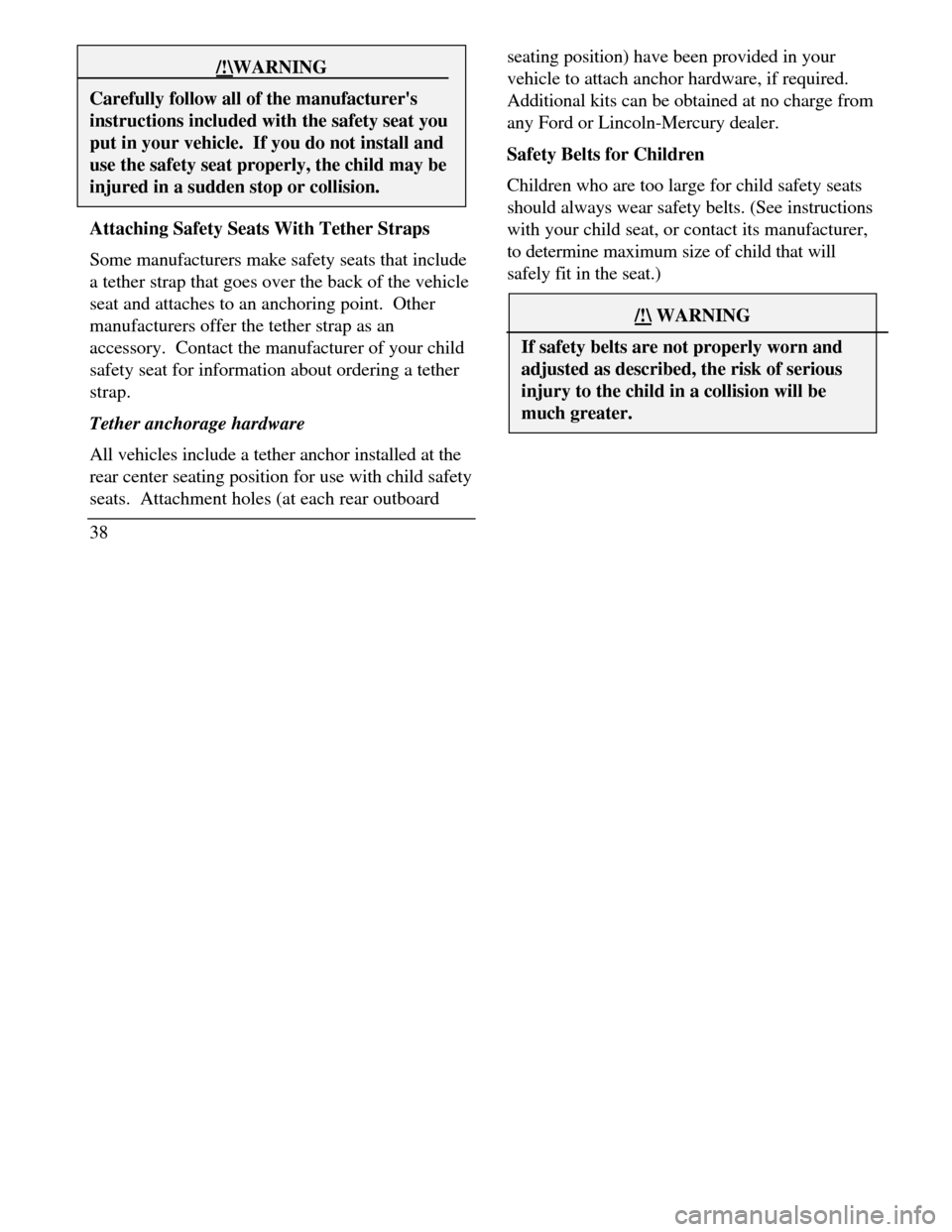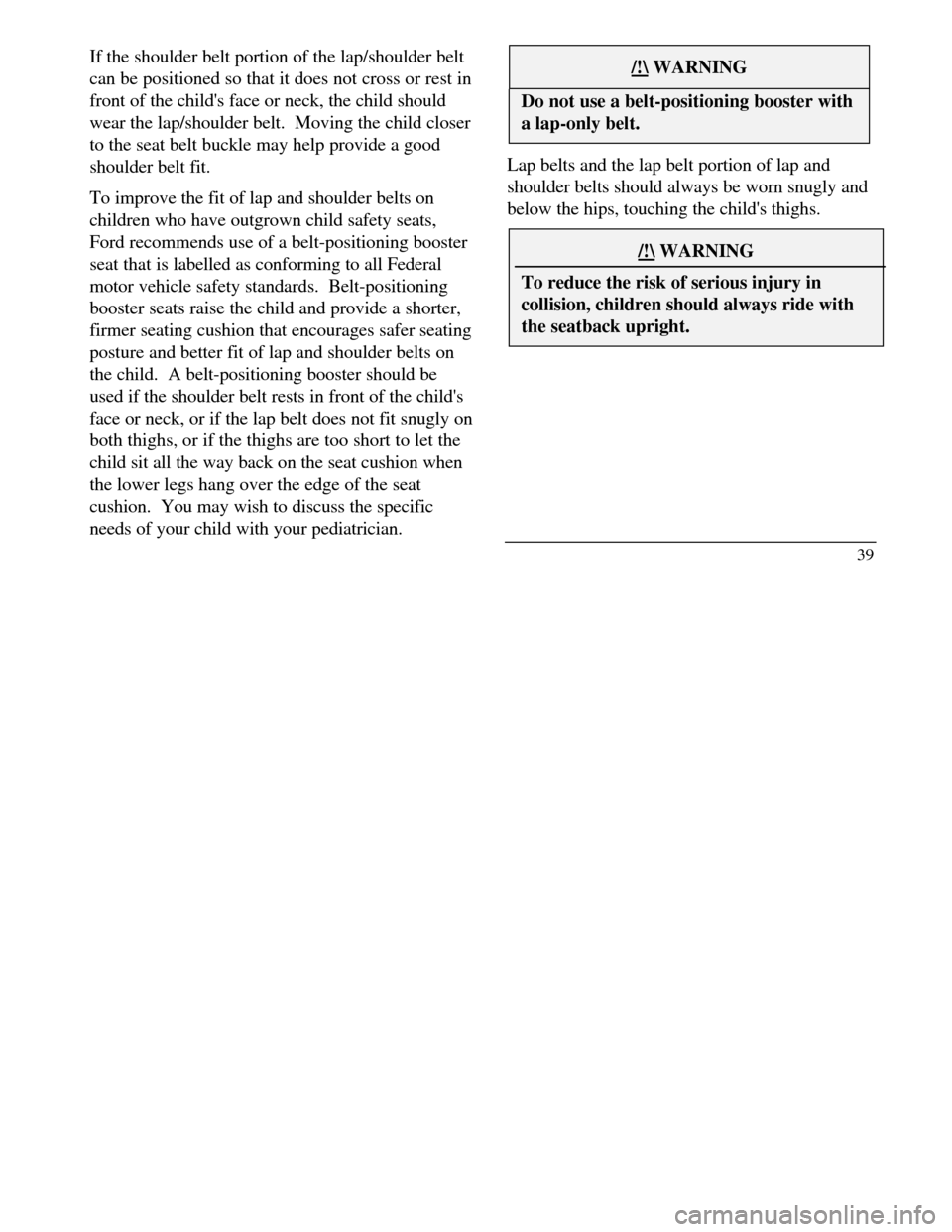Page 34 of 320
303. While holding the shoulder and lap belt
portions together, route the tongue through the
child seat according to the child seat
manufacturer's instructions. See Figure 2. Be
sure that the belt webbing is not twisted.
Page 35 of 320
Routing the lap/shoulder belt4. Insert the belt tongue into the proper buckle
for that seating position until you hear and feel
the latch engage. See Figure 3. Make sure
tongue is latched securely to buckle by pulling
on tongue.
31
Page 36 of 320
Buckling the belt
325. Grasp the shoulder portion of the belt and pull
downward until all of the belt is extracted and a
click is heard. At this time, the retractor is in
the automatic locking mode (child restraint
mode). See Figure 4.
NOTE:The dual locking mode retractor
must be in the automatic locking mode to properly
restrain a child seat.
Page 37 of 320
Setting the retractor to automatic locking
mode6. Allow the belt to retract. A clicking sound will
be heard as the belt retracts. This indicates the
retractor is in the automatic locking mode.
Pull on the lap belt portion across the child seat
towards the buckle and continue to pull up on
the shoulder belt portion while pushing down
on the child seat allowing the shoulder belt to
retract to remove any slack in the seat belt.
See Figures 5 and 6.
33
Page 40 of 320
8. Double check that the retractor is in the
automatic locking mode. Try to pull more belt
out of the retractor. If you cannot, the belt is in
the automatic locking mode. See Figure 8.
36Checking the retractor
Page 41 of 320

9. Check to make sure that the child seat is
properly secured prior to each use. If the
retractor is not locked, repeat steps 6 through
8.
NOTE:To remove the retractor from
automatic lock mode, allow seat belt to retract fully
to its stowed position and the retractor will
automatically switch back to the vehicle sensitive
locking mode for normal adult usage.
Installing a Child Safety, Seat at the
Front Center Seating Position with
Adjustable Lap Belt-
1.Lengthen the lap belt. To lengthen the belt,
hold the tongue so that its bottom is
perpendicular to the direction of webbing
while sliding the tongue up the webbing.
2. Place the child safety seat in the center seating
position.3.Route the tongue and webbing through the
child seat according to the child seat
manufacturer's instructions.
4. Insert the belt tongue into the proper buckle
for the center seating position until you hear
a snap and feel it latch. Make sure the
tongue is m securely fastened to the buckle
by pulling on tongue.
5. Push down on the child seat while pulling on
the loose end of the lap belt webbing to
tighten the belt.
6. Before placing the child into the child seat,
forcibly tilt the child seat from side-to-side
and in forward directions to ensure that the
seat is held securely in place. If the child seat
moves excessively, repeat steps 5 through 6,
or properly install the child seat in a different
seating position.
37
Page 42 of 320

/!\WARNINGCarefully follow all of the manufacturer'sinstructions included with the safety seat youput in your vehicle. If you do not install anduse the safety seat properly, the child may beinjured in a sudden stop or collision.Attaching Safety Seats With Tether Straps
Some manufacturers make safety seats that include
a tether strap that goes over the back of the vehicle
seat and attaches to an anchoring point. Other
manufacturers offer the tether strap as an
accessory. Contact the manufacturer of your child
safety seat for information about ordering a tether
strap.
Tether anchorage hardware
All vehicles include a tether anchor installed at the
rear center seating position for use with child safety
seats. Attachment holes (at each rear outboard
38seating position) have been provided in your
vehicle to attach anchor hardware, if required.
Additional kits can be obtained at no charge from
any Ford or Lincoln-Mercury dealer.
Safety Belts for Children
Children who are too large for child safety seats
should always wear safety belts. (See instructions
with your child seat, or contact its manufacturer,
to determine maximum size of child that will
safely fit in the seat.)/!\ WARNINGIf safety belts are not properly worn andadjusted as described, the risk of seriousinjury to the child in a collision will bemuch greater.
Page 43 of 320

If the shoulder belt portion of the lap/shoulder belt
can be positioned so that it does not cross or rest in
front of the child's face or neck, the child should
wear the lap/shoulder belt. Moving the child closer
to the seat belt buckle may help provide a good
shoulder belt fit.
To improve the fit of lap and shoulder belts on
children who have outgrown child safety seats,
Ford recommends use of a belt-positioning booster
seat that is labelled as conforming to all Federal
motor vehicle safety standards. Belt-positioning
booster seats raise the child and provide a shorter,
firmer seating cushion that encourages safer seating
posture and better fit of lap and shoulder belts on
the child. A belt-positioning booster should be
used if the shoulder belt rests in front of the child's
face or neck, or if the lap belt does not fit snugly on
both thighs, or if the thighs are too short to let the
child sit all the way back on the seat cushion when
the lower legs hang over the edge of the seat
cushion. You may wish to discuss the specific
needs of your child with your pediatrician./!\ WARNINGDo not use a belt-positioning booster witha lap-only belt.Lap belts and the lap belt portion of lap and
shoulder belts should always be worn snugly and
below the hips, touching the child's thighs./!\ WARNINGTo reduce the risk of serious injury incollision, children should always ride withthe seatback upright.39